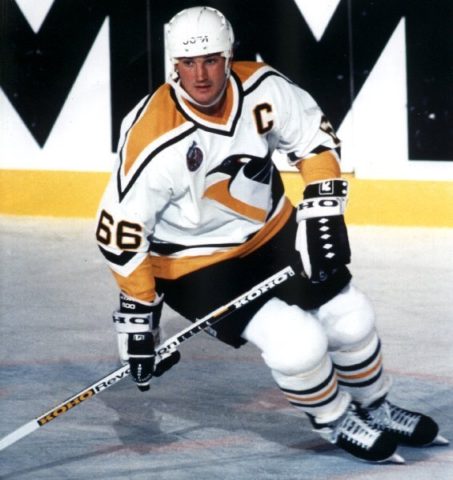Since the 1979-80 season, the Pittsburgh Penguins have employed some variation of the colors black and gold in their logo and on their uniforms. That same season, they debuted the iconic “skating penguin” logo that has since become synonymous with the franchise. It’s this logo that they wore during each of their five Stanley Cup-winning seasons, from the days of Mario Lemieux and Jaromír Jágr to Sidney Crosby and Evgeni Malkin. In between those eras, the Penguins donned the iconic “RoboPen”, a logo they should bring back as the NHL restarts its Reverse Retro jersey campaign.

Indeed, it has recently been reported that the Penguins may be planning to resurrect the logo for their latest addition to the NHL’s Reverse Retro jersey promotion that began two seasons ago. In doing so, the Penguins would be drawing on an era in team history defined by regular-season success and one that elicits a great deal of emotion for fans in Pittsburgh and around the league.
“RoboPen” Originally Introduced to Immediate Success

The Penguins originally introduced the “RoboPen” in 1992-93, the season that followed their back-to-back Stanley Cup championships. The first year with the new logo, which debuted on the then-white home jersey to go along with the “diagonal Pittsburgh” black road uniform, was a smashing success. They ended up finishing that season as the best team in the league, capturing the Presidents’ Trophy and ending with 56 wins, currently the team record for wins in a season. Four players, Lemieux, Kevin Stevens, Rick Tocchet, and Ron Francis all finished with 100 points or more, with Lemieux scoring an astonishing 69 goals, good for the team lead and third in the league, behind rookie sensation Teemu Selänne of the Winnipeg Jets and the Buffalo Sabres’ Alexander Mogilny.
During that season, the Penguins also set the record for the longest winning streak in league history at 17 games. They also finished 10 points ahead of the Boston Bruins, the next best team in the Wales Conference. The 1992-93 Stanley Cup Playoffs began in much the same manner as the regular season, with the Penguins quickly dispatching the New Jersey Devils in five games. Although they ultimately lost to the New York Islanders in seven games in the Wales Conference Semifinal, Lemieux and Francis once again carried the team, with Lemieux scoring 18 points in 11 playoff games.
“RoboPen” Holds a Great Deal of Meaning for Lemieux & Penguins
When Lemieux was drafted first overall in 1984, it was immediately predicted that he would become the saviour of the franchise. He quickly lived up to all the hype, leading the team to two Stanley Cups and becoming one of the best players of his generation. Coming off those championships, he entered the 1992-93 season as the Pens’ top scorer and was poised to repeat his successful performances of seasons past. However, Lemieux’s season and career (or so it seemed) came to an early end in Jan. 1993 when he was diagnosed with non-Hodgkin’s lymphoma. His campaign was believed to have ended as he took a leave from the team and spent the next two months undergoing radiation treatment.
At the conclusion of his treatment, Lemieux made his triumphant return to the ice, leading the Penguins against the hated Philadelphia Flyers. It was made legendary by the fact that the notoriously obnoxious Flyer fans greeted him with a standing ovation during warmup. Lemieux also scored his 40th goal of the season as the Penguins ultimately fell to the Flyers 5-4.
Related: Grading the NHL Reverse Retro Jerseys
Lemieux finished the season as the team’s top scorer, potting 69 goals and adding 91 assists for a total of 160 points. Although he had already become a hero to the city of Pittsburgh, the first season the team donned the “RoboPen” was when he became a legend.
“RoboPen” Still a Fixture When the Torch Was Passed
The Penguins utilized the “RoboPen” logo in an official capacity until 2002 when it was relegated to the secondary logo and placed on the jersey’s shoulder in favour of the classic “skating penguin”. Even so, it remained part of the uniform for the changing of the guard, which saw the arrival of Crosby, Malkin, and Kris Letang. This was the uniform the Penguins wore when the metaphorical torch was passed, and also when Lemieux officially retired and Crosby became the new face.

Perhaps there is no logo in the history of the Penguins that has sparked more controversy than the “RoboPen”. After all, it seems as though it remains the subject of heated debate and some fans utterly despise it for what it purportedly symbolizes. During the original era, the Penguins traded Jágr to the Washington Capitals and experienced attendance plights and a bankruptcy scare that didn’t dissipate until Crosby’s arrival. However, it was also marked by some of the most triumphant moments in franchise history, and bringing the logo back for the latest edition of the Reverse Retro campaign will be a massive nostalgia blast for those who grew up with it.
